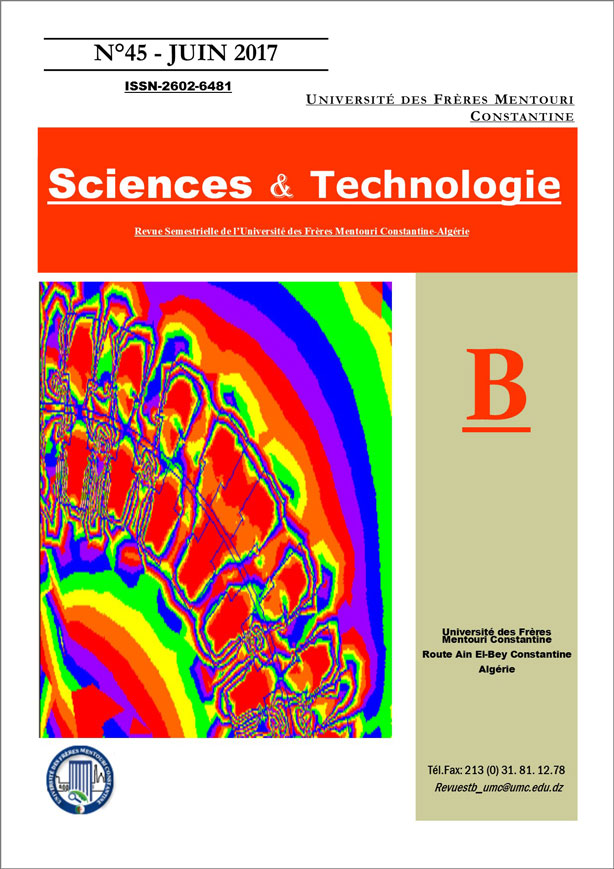NUMERICAL STUDY OF A HYBRID PHOTOVOLTAIC/THERMAL SOLAR COLLECTOR USING TWO DIFFERENT GLAZING
Mots-clés :
Air, Glass, PMMA, Performances, Photovoltaic/ThermalRésumé
Les matières plastiques ont été révélés les matériaux les plus largement utilisés pour la construction des différents composants tels que les appareils de chauffage solaire. Dans ce travail, une étude numérique sur les performances d'un capteur solaire hybride photovoltaïque / thermique (PV / T) a été développée.
Le but de cette étude est de comparer les rendements du système hybride photovoltaïque / thermique en utilisant des matériaux plastiques comme couverture avec ceux du verre, Le modèle est basé sur le bilan énergétique pour différents noeuds du système. Le système étudié est composé d'un vitrage transparent: le verre ou le poly (méthacrylate de méthyle) (PMMA), ce matériau peut être recyclable, a une grande résistance aux contraintes thermiques et économique par rapport au verre.
Sur la base des résultats numériques, l'utilisation du PMMA est bénéfique pour transmettre plus de la chaleur et améliore les performances thermiques du système étudié, le rendement global du système hybride PV / T est de 88,695% et 87,385% respectivement pour l'utilisation de PMMA ou de verre comme vitrage.
Références
G.N. Tiwari, R.K. Mishra, S.C. Solanki, Photovoltaic modules and their applications: A review on thermal modeling. Applied Energy. Vol. 88 (2011).pp. 2287-2304.
C. Good, Environmental impact assessments of hybrid photovoltaic-thermal (PV/T) systems-A review. Renewable and Sustainable Energy Reviews. Vol.55 (2016).pp. 234-239.
A. Ibrahim, M.Y. Othman, M.H. Ruselan, S. Mat, K. Sopian, Recent advances in flat plate photovoltaic/thermal (PV/T) solar collectors. Renewable and Sustainable Energy Reviews. Vol. 15(2011). pp. 352-365.
J.J. Michael, S. Iniyan, R.Goic , Flat plate solar photovoltaic-thermal (PV/T) systems: A reference guide. Renewable and Sustainable Energy Reviews.Vol.51(2015). pp. 62-88.
C. Cristofari, G. Notton, J. L. Canaletti, Thermal behavior of a copolymer PV/TH solar system in low flow rate Conditions. Solar Energy.Vol. 83 (2009). pp.1123-1138.
G. Notton, C. Cristofari, M. Mattei, P. Poggi, Modelling of double-glass photovoltaic module using finite differences. Applied Thermal Engineering. Vol. 25 (2005). pp. 2854-2877.
A. Tiwari, M.S. Sodha, Parametric study of various configurations of hybrid PV/thermal air collector: Experimental Validation of theoretical model. Solar Energy Materials and Solar Cells. Vol. 91 (2007). pp. 17-28.
A.S. Joshi, A. Tiwari, G.N. Tiwari, I . Dincer, Reddy B.V, Performance evaluation of a hybrid photovoltaic thermal (PV/T) (glass-to-glass) system. International Journal of Thermal Sciences. Vol. 8 (2009). pp. 154-164.
J.K. Tonui, Y. Triapanagnostopoulos, Air-cooled PV/T solar collectors with low cost performance improvements. Solar Energy. Vol.81(2007). pp. 498-511.
A. Hegazy, Comparative study of the performances of four photovoltaic/thermal solar air collectors. Energy Conversion and Management. Vol.41(2000). pp. 861-881.
D. Su, Y. Jia, G. Alva, Y. Tang, G. Fang, Dynamic performance analysis of photovoltaic-thermal solar collector with dual channels for different fluids. Energy Conversion and Management. Vol.120(2016). pp. 13-24.
A. Blaga, Use of plastics in solar energy applications. Solar Energy. Vol. 21(1978). pp. 331-338.
F. E. Edlin, Plastic glazing for solar energy absorption collectors. The Annual Meeting of the American Society of Mechanical Engineers,New York. December, 1957. pp. 1-6.
F.C.O.Brien Bernini, J.G. McGowan, Performance of non-metallic flat plate solar collectors. Solar Energy. Vol.33 (1984). pp.305-319.
T. Koyuncu, Performance of various designs of solar air heaters for crop drying applications. Renewable Energy. Vol. 31 (2006). pp.10073-1088.
A. DuffieJ, W. A. Beckman, Solar Engineering of Thermal Processes, John Wiley&SonsInc, New York, 1991.
K. S. Ong, Thermal performance of solar air heaters: Mathematical model and solution procedure. Solar Energy. Vol.55(1995). pp. 93-109.
G. N. Tiwari, S. Dubey, Fundamentals of Photovoltaic Modules and Their Applications, RSC Energy. Series N° 2. 2010.
F. P. Incropera, Fundamentals of Heat and Mass Transfer. Johns Wiley &Sons, 2006.
Mahesh.M.Rathore, Engineering Heat and Mass Transfer. Laxmi Publications (P) LTD , 2006.
W. Gao, W. Lin, T. Liu, C. Xia, Analytical and experimental studies on the thermal performance of cross-corrugated and flat plate solar air heaters. Applied Energy.Vol. 84 (2007). pp. 425-441.
A .Tiwari, M.S Sodha, A .Chandra, J.C. Joshi, Performance evaluation of photovoltaic thermal solar air collector for composite climate of India. Solar Energy Materials and Solar Cells.Vol. 90 (2006). pp. 175-189.
J.P. Holman, Heat Transfer. 10th ed., McGraw-Hill series in Mechanical Engineering, 2010.
http://www.accuweather.com/fr/dz/constantine/ Accessed 30 Juin 2016.
M. Abderrezek, M. Fathi, S. Mekhilef, F. Djahli, Effect of Temperature on the GaInP/GaAs Tandem Solar Cell Performances, International Journal of Renewable Energy Research. Vol.5 No.2 (2015). pp. 629-635.
P. Singh , N.M. Ravindra, Temperature dependence of solar cell performance-an analysis. Solar Energy Materials & Solar Cells. Vol.101(2012). pp. 36-45.
Y. Triapanagnostopoulos, Aspects and improvements of hybrid photovoltaic/thermal solar energy systems. Solar Energy. Vol. 81 (2007). pp. 1117-1131.
Téléchargements
Publié
Numéro
Rubrique
Licence
Les auteurs publiant dans cette revue acceptent les termes suivants :- Les auteurs détiennent le droit d'auteurs et accordent à la revue
le droit de première publication, avec l’ouvrage disponible simultanément [SPÉCIFIER LA PÉRIODE DE TEMPS] après publication, sous la licence Licence d’attribution Creative Commons qui permet à d'autres de partager l'ouvrage en en reconnaissant la paternité et la publication initiale dans cette revue. - Les auteurs peuvent conclure des ententes contractuelles additionnelles et séparées pour la diffusion non exclusive de la version imprimée de l'ouvrage par la revue (par ex., le dépôt institutionnel ou la publication dans un livre), accompagné d'une mention reconnaissant sa publication initiale dans cette revue.
- Les auteurs ont le droit et sont encouragés à publier leur ouvrage en ligne (par ex., dans un dépôt institutionnel ou sur le site Web d'une institution) avant et pendant le processus de soumission, car cela peut mener à des échanges fructueux ainsi qu'à un nombre plus important, plus rapidement, de références à l’ouvrage publié (Consulter The Effect of Open Access).

